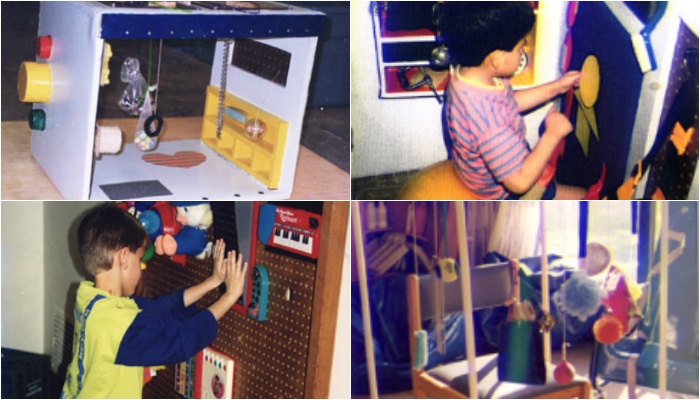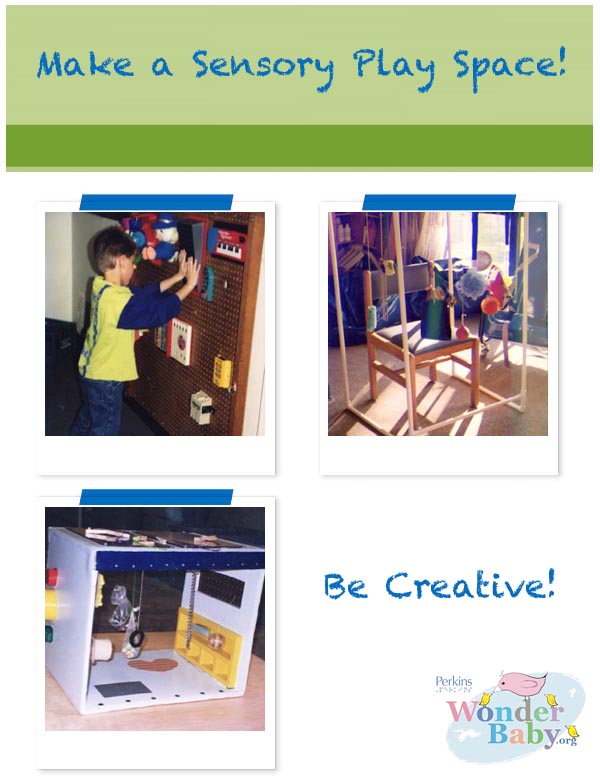Creating Sensory Activity Centers for Blind Children

Children who are blind, physically limited or highly distractible may not independently explore their “regular” environment. They may benefit from specialized activity centers.
Activity centers concentrate a variety of stimulating items in a small space with clear boundaries. Activity centers can be made to put on the floor, to rest on a table top, to attach to a single wall or to fill a whole corner of a room from floor to ceiling.
An activity center can be built out of wood, plastic or cardboard. The corner structure reflects sound and defines the limits of the exploration area. Shelves and various shaped hiding places can be built into the structure. Pegboard can be combined with the cardboard so that interesting items can be bolted in place.
Remember, when constructing your activity center that it is important to have easy access to the back of the center in order to change or repair mounted items.
What Should You Put in Your Activity Center?
Items in an activity center need to maximize stimulation and motivation. An auditory-tactile play space needs items that have interesting sounds and textures.
Carefully vary the “things” you choose to put in the activity center:
- Include some heavy and some light items
- Include some rough, soft, smooth, sticky and tickly items
- Include some items with moveable parts
- Light-weight plastic materials can be boring. Wood, metal or cloth items can feel a lot more interesting
- Household items are often more interesting than toys
Examples of specific items for activity corners include:
- Chains
- Egg Beaters
- Slinkies
- Springs
- Spinners
- Bells
- Rain Sticks
- Scented Bean Bags
- Brushes
- Magnets
- Velcroed Items
- Hanging Cords
- Pocket books
- Musical Keyboards
- Dolls or stuffed animals
It’s all right if the end result looks a bit cluttered. What appears to be an overwhelming jumble is an accessible and stimulating set of choices for exploration!
Benefits of an Activity Center
When children are motivated to explore their environment they often push themselves beyond their normal limits. The following are examples of actions and their therapeutic benefits:
- Reaching above shoulder height to find fun items can improve shoulder stability and extension patterns.
- Playing with items on a vertical surface enhances wrist extension.
- Playing with items that can only be reached from a standing position increases standing tolerance and improves weight bearing.
- Sitting on a T-stool or therapy ball while exploring materials improves automatic balance responses.
- Searching for favorite items in remembered locations develops spatial relationships.
More Activity Center Ideas
 The Sensory Corner
The Sensory Corner
This small corner is made with velcro and cardboard. This space is an extremely stimulating area because of all the different options it provides for play and exploration.
The large ball this child is sitting on allows him to bounce or rock back and forth, there are springy cords and all sorts of varied household objects.
 The Cardboard Activity Center
The Cardboard Activity Center
This sensory space is made out of card board and drywall. It has many visually and physically varied objects for a child to explore.
 The Room Sized Activity Center
The Room Sized Activity Center
Here is an example of a sensory space that is made to accommodate larger children. This space is made completely out of cardboard. It has cloth curtains so that the child can fully shut himself into this place to retreat. The inside is full of pillows to make the child more comfortable.
 The Big Room Sensory Space
The Big Room Sensory Space
This is an entire corner of a room that has been made into a large sensory environment. For those who are either physically or developmentally challenged, this kind of set up is both relaxing and comforting.
The room is covered with soft textures that vary in shape and color and christmas lights have been hung from the walls.
 The Sensory Chair
The Sensory Chair
This is a sensory tool that is designed for an older child who doesn’t have much mobility. The set up is perfect for a child in a wheelchair.
The frame is made out of PVC pipes and the toys are simply hung from the top. One attribute that this lacks is there is no sound reverberation. Nonetheless, this set up is great for those kids who are learning to reach out and explore.
You can make a similar smaller space for younger children and have it fit around a small comfortable and supportive seat.
Read this article in Arabic: قراءة هذا المقال بالعربية
Read this article in Spanish: Lea este articulo en Español

Related Posts

Eye Conditions and Syndromes, Visual Impairment
Neuralink Announces Plans to Restore Sight to the Blind with Brain Chip
Elon Musk’s company Neuralink has announced plans to begin human trials of its new “Blindsight” brain chip by the end of 2025.

Visual Impairment
The Gift of Understanding: How a Young Child Helps His Blind Father Navigate Life
When a parent is blind, it’s natural for people to wonder how their sighted child will adapt. Will they struggle to understand their parent’s needs? Will they feel burdened by...

Braille and Literacy, Toys, Visual Impairment
24 Braille Toys for Kids Who are Blind
Everything from alphabet blocks to raised line coloring pages and activity books to puzzles to card and board games... and so much more! And it's all in braille ready for...